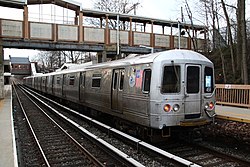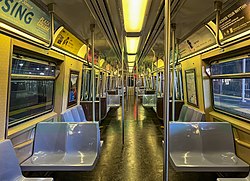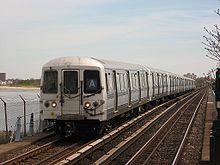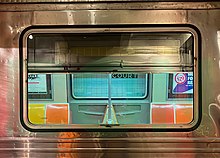R44 (New York City Subway car)
| R44 | |
|---|---|
 An R44 train on theStaten Island Railway(SIR) atOakwood Heights | |
 Interior of a SIR R44 car | |
| In service | 1971–2010 (NYCT cars) 1973–present (SIR cars) |
| Manufacturer | St. Louis Car Company |
| Built at | St. Louis, Missouri,USA |
| Replaced | |
| Constructed | 1971–1973 |
| Entered service |
|
| Refurbished | May 1991 – January 1993, 2007 – 2010 (SIR cars) |
| Scrapped | 2012–2013 (NYCT cars & one damaged SIR car), 2024–present (remaining SIR cars) |
| Number built | 352 |
| Number in service | 55 (SIR cars)[1] |
| Number preserved | 1 |
| Number scrapped | 295 290 (283 NYCT cars and 7 SIR cars) 5 in storage (4 NYCT cars and 1 SIR car)[1] |
| Successor | R160(NYCT) R211S(SIR) |
| Formation | Single units (SIR), 4 car sets (NYCT) |
| Fleet numbers | 5202–5479 (NYC Subway) 388–435, 436–466 (even) (SIRTOA) (cars originally numbered 100–435, 436–466 (even)) |
| Capacity | A car:72 (seated) B car:76 (seated) |
| Operators | New York City Subway (1971–2010) Staten Island Railway (1973–present) |
| Depots | Clifton Yard[2][3] |
| Service(s) assigned | |
| Specifications | |
| Car body construction | Stainless steelwithcarbon steelchassis and underbody,withfiberglassend bonnets |
| Car length | 74 ft 8.5 in (22.77 m) (overanticlimbers) |
| Width | 10 ft (3,048 mm) (over threshold) |
| Height | 12.08 ft (3,682 mm) |
| Platform height | 3.76 ft (1.15 m) |
| Doors | 8 50-inch-wide side doors per car (4 per side) |
| Maximum speed | Test:87.75 mph (141.22 km/h) Service:55 mph (89 km/h)–60 mph (97 km/h) |
| Weight | A train car:88,950 lb (40,347 kg) B train car:84,530 lb (38,342 kg) |
| Traction system | NYC Subway:Westinghouse E-CAM XCA448F propulsion with Westinghouse 1447F motors 115 hp (85.8 kW) on all axles Staten Island Railway:General ElectricSCM-CAM 17KG192A1 propulsion with GE 1257E1 motors 115 hp (85.8 kW) on all axles |
| Prime mover(s) | electric motor |
| Acceleration | 2.5 mph/s (4.0 km/(h⋅s)) |
| Deceleration | 3.0 mph/s (4.8 km/(h⋅s)) (Full Service) 3.2 mph/s (5.1 km/(h⋅s)) (Emergency) |
| Electric system(s) | Third rail,600 V DC |
| Current collector(s) | Contact shoe |
| Braking system(s) | NYC Subway:Westcode(dynamic and friction), WABCOtread brakeunit Staten Island Railway:WABCORT5C (dynamicandfriction), WABCOtread brakeunit |
| Safety system(s) | ATO,dead man's switch,pulse code cab signaling,tripcock |
| Headlight type | halogen light bulbs |
| Track gauge | 4 ft8+1⁄2in(1,435 mm)standard gauge |
TheR44is aNew York City Subwaycar model built by theSt. Louis Car Companyfrom 1971 to 1973 for theB Divisionand theStaten Island Railway(SIR). The cars replaced manyR1–9 seriescars, and all remaining1925 Standard Steel built SIRTOA ME-1trains, providingStaten Islandwith a new fleet of railcars. The R44 fleet originally consisted of 352 cars, of which 56 remain in service, all on the Staten Island Railway.
The first R44 cars entered service on the subway on April 19, 1972, and on the Staten Island Railway on February 28, 1973. Various modifications were made over the years to the R44 fleet. The R44s set theworld speed recordfor a subway car in 1972, reaching a top speed of 87.75 mph (141.22 km/h). In the early 1990s, the R44 cars were rebuilt byMorrison–Knudsenfor theNew York City Transit Authority.Though theR160order replaced all New York City Subway-operated R44s from December 18, 2009[4]to September 16, 2010, because of structural integrity issues found on them, the Staten Island Railway fleet remains in operation and is to be replaced by theR211order by 2024–2025. As of 2024, the R44s are the oldest active rolling stock within the NYCT system, following the retirement of theR32s.
Description
[edit]A total of 352 R44 cars were ordered; 300 cars for the New York City Subway (numbered 100–399, with 278 of the cars later renumbered 5202–5479) and 52 cars for theStaten Island Railway(also known asME-2,MU-2,orMUE-2cars, numbered 400–435 and even numbers between 436 and 466).[5][6]They were the last subway cars built by the St. Louis Car Company prior to shutting down in 1974.
The R44s originally came in singles, but needed each other to run, much like the "married pairs" of subway cars before them (R26toR42,exceptR33S). The NYCT cars were reassembled after overhaul intoABBAsets of four;Acars are evenly numbered with a full-width operator cabs at the number 1 end, while theBcars have odd numbers and no cabs at either end. The SIR cars were not reassembled after overhaul and remain as single units.
The R44s were also factory equipped withautomatic train operation(ATO) equipment, in anticipation of their use on the newSecond Avenue SubwayLine that was being built at the time.
Since September 16, 2010, all NYCT R44 cars have been retired and replaced by the R160s due to structural integrity issues found on those cars, leaving the SIR as the sole operator of the R44. The R44 cars in service on SIR are maintained atClifton Yard,with heavier maintenance being performed atConey Island Yard.
Firsts
[edit]The R44 was the first 75-foot (23 m) car for the New York City Subway. The cars were introduced under the idea that a train of eight 75-foot (22.86 m) cars would be more efficient than one of ten 60-foot (18.29 m) cars.[7]Despite the increase in length, the R44s had eight pairs of doors per car (four on each side) like previous B Division cars. As a result, eight 75-foot (22.86 m) cars have only 64 (32 per side) pairs, whereas ten cars have 80 (40 per side). The reduced number of doors on a train of eight 75-foot (22.86 m) cars increased boarding and dwell times, so recent car orders have returned to ten 60-foot (18.29 m) cars, starting with theR143.
The interior design was very different from previous models. The R44s had orange and yellow plastic bucket seats—a feature that would be incorporated into the other 75-foot (22.86 m) B-division cars and the A-divisionR62sandR62As.The seats were protected from the doorways by faux wood and glass panels. They were also the first car class delivered with crosswise seating since theR16order from 1954. The walls were tan with "wallpaper" featuring the seals ofNew York StateandNew York Citymade from graffiti-resistant Formica plastics. The new interior decor was carried over to theR46fleet.
The R44 was the first car since theBMT Green Hornetto incorporate a two-note warning tone, the first two notes ofWestminster Quarters,that sounds before the doors begin to close as the train prepares to leave the station. When the cars were built, the chime was sounded four seconds before the doors closed, but the time delay was later removed.[8]This has become the signature sound of the subway and is used with all subsequent cars.[9]
The R44s were also the first NYCT subway cars to feature a newly designed WABCO-RT5 electronically and pneumatically controlled braking system also known as the P-Wire system, which did not fare well with this fleet of cars (similar systems also plagued the R46s), since most of the shop personnel were not adequately trained to deal with the P-Wire braking system's sophisticated fail/safe design for automatic train operation. The system would sometimes trigger the train's emergency braking system unexpectedly, which caused a situation known as stuck brakes. This P-Wire system, along with all of the automation systems (ATO) installed when these cars were built in 1972, was removed from the R44s beginning in 1984, and was replaced by a more conventional Westcode SMEE type braking system which made these cars much more reliable than with the originally installed system. The SIR cars had the same system, but fared much better than the NYCT cars.
Therollsignsfrom eight R44s were removed and replaced by experimentalflip-dot signsstarting in 1988, the same year the New Technology Program began. These experimental flip-dots signs were replaced by electronic LCD signs on the sides and rollsigns on the front during the General Overhaul Program from 1991 to 1993.
The R44s were designed to be automated and had a high design top speed of 70 mph (110 km/h) in anticipation of operation on new subway lines to be built, such as theSecond Avenue Subway,which never opened while the cars were in subway service.[7]On January 31, 1972, the R44s set theworld speed recordfor a subway car, when a consist reached a speed of 87.75 mph (141.22 km/h) on theLong Island Rail Road's main line betweenWoodsideandJamaica.With two motors per car disabled, the cars still reached 77 mph (124 km/h). The cars were capable of attaining even higher speeds, but the length of the test track was insufficient to allow further acceleration.[10][11]
History
[edit]Pre-introduction
[edit]To ensure the subway could accommodate 75-foot (22.86 m) cars, three retiredR1cars (numbered 165, 192, and 211;[12]renumbered XC675, XC575, and XC775 respectively) were repurposed and sent to various places around the subway and the Staten Island Railway. Cars XC675 and XC575 were cut in half and lengthened to 75 feet (22.86 m).[13]
As a result of the tests, it was determined that only minor changes to tunnels were needed to fit the 75-foot cars,[7]and that particular segments on theBMT Eastern Division(theJ/Z,L,andM) would be too difficult to convert to allow 75-foot (22.86 m) cars to operate safely. As such, the R44s were not delivered to those lines.
At the end of 1969, bids were received and a contract was awarded for an order of 240 75-foot R44 subway cars, with an option for 60 additional cars at the end of 1969.[7]
Delivery and early mishaps
[edit]
After many months of exhaustive testing on theA,D,E,andF(one week on each service, starting December 16, 1971), as well as on the LIRR to test the cars' state-of-the-art electrical and mechanical systems, the first set of R44s was placed in service on the New York City Subway on theFon April 19, 1972, following a brief introductory ceremony attended by theMayor of New York CityJohn V. Lindsay,along with MTA ChairmanWilliam J. RonanatJamaica–179th Street station.The Staten Island R44s were delivered between January and April 1973.[10]The first six Staten Island R44s went into service on February 28, 1973.[11][14]With the completion of the R44 order and the similarState of the Art Car,the St. Louis Car Company shut down operations.
An eight-car train (328–335) was tested in 1973 with carpeting, and another (380–387) was tested with hydraulic brakes that were incompatible with the rest of the R44s' braking systems.[15]In 1979, seven of the eight cars had these systems removed and replaced with conventional air brakes, while the last car (car 385) was permanently removed from service.[10]
GE cars 388–399 were not converted to Westcode SMEE braking system in 1984, and were eventually sent to theStaten Island Railwayin 1985 to provide SIRTOA with some extra cars since ridership increased significantly in 1985, so their existing 52-car fleet would not be overly taxed. These 12 R44 cars were built identical to the SIRTOA's specification with GE propulsion instead of Westinghouse.[citation needed]
In 1983, organizations for the blind stated that the gaps in between R44 and R46 cars were dangerous, since the blind could mistake the spaces for doorways.[16]
Nine NYCT R44s were involved in various listed incidents that led to their premature retirements before theGeneral Overhaul Program(GOH) program for the R44s commenced. These cars, along with car 385, were not overhauled during the GOH program; they were instead stored on the system and stripped of parts until March 2001, when they were shipped off property and scrapped.[17][18]
General Overhaul Program and post-overhaul
[edit]

During the General Overhaul Program, from 1991 to 1993, 342 R44s were rebuilt by the NYCT either at the207th Street YardinManhattanor theConey Island ComplexinBrooklyn(cars 5342–5479 and all SIR cars) and byMorrison–Knudsenoff NYCT premises (cars 5202–5341).[19]Some improvements included the repainting of the carbon steel blue stripes into silver gray stripes (most NYCT cars) or the replacement of the stripes with stainless steel panels (NYCT cars 5228–5229 and all SIR cars). Therollsignson the sides were replaced withelectronic LCD signson the NYCT cars and were completely removed on the SIR cars. The SIR R44s, however, retained their original two-note warning tones from their entry into service, unlike their NYCT counterparts, which had their warning tones replaced with the same ones that are found on theR46s,R62s,R62As,R68s,andR68As.
Even after the GOH program, several NYCT R44s were retired due to various mishaps. Cars 5319 and 5402 were damaged in separate fire-related incidents. Cars 5282–5285 were involved in a derailment north of135th Street,resulting in the whole set being placed out of service.[20]Car 5248 was taken out of service in 2004 due to crackedtruck bolsters.Cars 5282 and 5319 were completely destroyed and subsequently scrapped in the late 1990s,[21]car 5284 was eventually repaired and returned to service, and the other damaged cars were stored out of service for parts until they were scrapped with the rest of the NYCT cars.
All SIR cars were overhauled for a second time between 2007 and 2010 as a part of scheduled maintenance program. Several improvements included the repainting of the bulkheads, rebuilt trucks, new dark floors, newly repainted periwinkle bucket seats, and updated logos; unlike the NYCT cars, the SIR cars retained their original blue "M" MTA decals during their first overhaul.[10]The cars have been undergoing further intermittent rounds of scheduled maintenance as their parts age over time.
Even after their second overhaul, several SIR R44s were retired due to various mishaps. On December 26, 2008, car 402 was pulled from service after being badly damaged from accidentally hitting a bumper block at theTottenvillestation.[22]It was stored at207th Street Yardand stripped of parts for other SIR cars; by 2013, it was scrapped.[23]In May 2013, cars 399 and466were taken out of service after being damaged in a sideswipe.[24]Both cars were also stripped of parts for other SIR cars.[25]
Retirement
[edit]NYCT cars
[edit]
On December 18, 2009, two 4-car sets of New York City Transit R44s, one set being a contract Morrison-Knudsen rebuild and the other being an in-house Coney Island Overhaul Shop rebuild, were brought in to the 207th Street Overhaul Shop for inspection; the inspection resulted in various structural integrity issues being discovered on all eight cars. As the R44s were originally planned to be retired by theR179order,[26]the decision was made in March 2010 to retire the R44s with the remainingR160order in place of theR32andR42fleet, which were being replaced with the R160 order at the time; that same month, withdrawal of the NYCT R44 fleet from revenue service began, and retirement of the R32 and R42 fleet paused indefinitely.
Initially the retired NYCT R44s were to be reefed. Cars 5342–5345, one of the sets that were brought in for inspection, were amongst the first to be completely stripped in preparation for disposition as artificial reefs since the decision was made to retire the fleet. However, after car 5344 presented a serious contamination hazard that was dangerous to the aquatic life in the ocean and would have proven too costly for artificial reef preparation for the NYCT R44s and the artificial reef program as a whole ending on April 2010 anyways, the plan to reef the NYCT R44s was ultimately cancelled in favor of simply scrapping them at Sims Mental Management.[27]The NYCT R44s were gradually phased out until September 16, 2010, when the last train made its final trips on theAandC.After retirement, the NYCT R44s were mothballed and placed into storage system-wide.[28]From May 2012 until summer 2013, most of the NYCT R44s were scrapped atSims Metal Management.[29][30]Four cars, 5286–5289, were not scrapped and remain stored at Coney Island Yard.[31]The only car not slated for disposal is car 5240 (originally 172), which has since been preserved and set aside for on-and-off display at theNew York Transit Museum.
Staten Island Railway cars
[edit]Since January 2022, the remaining R44s have been the oldest active rolling stock within the NYCT system at51 years old, following the retirement of theR32s.
Like the NYCT cars, the SIR R44s were originally planned to be retired by theR179order; however, this plan was dropped. Proposals to overhaul and operate someR46son the SIR to replace the R44s there surfaced instead; however, this plan was also dropped. As such, the SIR R44s not written off received intermittent rounds of scheduled maintenance to extend their usefulness until retirement.[26][32]
Ultimately, 75R211Scars have been ordered to replace the SIR R44s; these started entering service on October 8, 2024.[33]The SIR R44s are being gradually phased out from mid-2023, with a handful of cars being retired and cannibalized for parts to keep other cars running.[1]The remainder of the active cars are expected to be phased out between 2024 and 2026.[34][35][36][37]
References
[edit]- ^abc@techno_7843."St. Louis Car Company R44M/ME-2 424 at St. George Terminal, on the @mta's Staten Island Railway. Taken 10/3/23. This car has been retired".Instagram.
- ^"Car Assignments: Cars Required June 30, 2024"(PDF).The Bulletin.67(7). Electric Railroaders' Association. July 2024.RetrievedJuly 26,2024.
- ^
- 'Subdivision 'A' Car Assignment Effective December 19, 2021'.New York City Transit, Operations Planning.December 17, 2021.
- 'Subdivision 'B' Car Assignment Effective December 19, 2021'.New York City Transit, Operations Planning.December 17, 2021.
- ^Chiasson, George (March 2010)."New York City Subway Car Update"(PDF).The Bulletin.53(3). Electric Railroaders' Association: 7.RetrievedMarch 1,2022.
- ^New York: R-44s set a fast paceRailway AgeMarch 6, 1972, pages 49/50
- ^"New York's R-44 cars enter service".Railway Gazette International.July 1972. p. 275.
- ^abcdAnnual Report - Metropolitan Transportation Authority.1969. p. 21.
- ^Davis, Ed Sr. (June 1985)."Chapter 10, The Space Age on Rails".They Moved the Millions.Livingston Enterprises. Section A: A New Breed; the R44.ISBN978-9996650697.RetrievedApril 8,2015.
- ^"Audible Information Design in the New York City Subway System: A Case Study"(PDF).RetrievedJanuary 30,2015.
- ^abcd"R-44 (St. Louis, 1971-1973)".nycsubway.org.1995–2012.RetrievedApril 5,2015.
- ^ab"New York City Transit Facts & Figures: 1979"(PDF).La Guardia and Wagner Archives.Metropolitan Transportation Authority,New York City Transit Authority.1979.RetrievedOctober 24,2016.
- ^Oszustowicz, Eric; et al. (March 2006)."A History of the R-1 to R-9 Passenger Car Fleet"(PDF).The Bulletin.Vol. 49, no. 3. New York Division, Electric Railroaders’ Association. p. 37.RetrievedMay 24,2022.
- ^Car XC675 (ex-165):
- Testagrose, Joe (September 1970).Car XC675 (ex-165) at Coney Island Yard.nycsubway.org(Photograph).RetrievedApril 5,2015.
- Grotjahn, Doug (June 1, 1970).Car XC575 (ex-192) at Tottenville on SIRT.nycsubway.org(Photograph).RetrievedApril 6,2015.
- Testagrose, Joe (June 7, 1970).Car XC575 (ex-192) at St. George on SIRT.nycsubway.org(Photograph).RetrievedApril 6,2015.
- Grotjahn, Doug (September 27, 1970).Car XC575 (ex-192) at Jefferson Avenue on SIRT.nycsubway.org(Photograph).RetrievedApril 6,2015.
- Hoskins, Steve (August 1976).Car XC675 (ex-165) at Coney Island Yard.nycsubway.org(Photograph).RetrievedApril 5,2015.
- ^1968-1973, the ten-year program at the halfway mark.New York. 1973.hdl:2027/mdp.39015023095485.
- ^Prial, Frank J. (March 12, 1973)."Carpeting Is Popular On the IND".The New York Times.ISSN0362-4331.RetrievedDecember 25,2016– via New York Times Archive.
- ^May, Clifford D. (January 6, 1983)."Subway Cars Held Perilous for the Blind".The New York Times.ISSN0362-4331.RetrievedFebruary 13,2018.
- ^spicker613 (March 19, 2001).Original Kodachrome Slide NYC Subway R-44 120/109 207 Yard Scrap March 19, 2001.Flickr(Photograph).RetrievedApril 8,2015.
{{cite AV media}}:CS1 maint: numeric names: authors list (link) - ^spicker613 (March 19, 2001).Original Kodachrome Slide NYC Subway R-44 248, R-62 1439 Barge March 19, 2001.Flickr(Photograph).RetrievedApril 8,2015.
{{cite AV media}}:CS1 maint: numeric names: authors list (link) - ^EquipmentRailway AgeJanuary 1990 page 8
- ^Barron, James (July 5, 1997)."Investigators Seek Clues to Explain Subway Train Derailment".The New York Times.RetrievedApril 8,2015.
- ^Train Crash(Photograph). May 2018. Archived fromthe originalon December 18, 2018.RetrievedMarch 1,2022.
- ^"Train derailment at Staten Island Railway station cost city MTA more than a half-million dollars".April 30, 2009.
- ^Dooley, John (November 29, 2011).R-44 at 207th Street Yard.nycsubway.org(Photograph).RetrievedOctober 3,2015.
- ^Bulletin 2013erausa.org
- ^"Google Maps".
- ^ab"MTA Capital Program 2008–2013"(PDF).Metropolitan Transportation Authority.February 2008. p. 28.RetrievedApril 8,2015.
- ^Chiasson, George (June 2010)."New York City Subway Car Update"(PDF).The Bulletin.53(6). Electric Railroaders' Association: 19.RetrievedSeptember 24,2024.
- ^Dooley, John (August 26, 2011).R-44 Car 5286 Pending Scrap.nycsubway.org(Photograph).RetrievedApril 8,2015.
- ^Noel, Nicholas (January 28, 2013).R-44 Car 5332 on Tractor Trailer.nycsubway.org(Photograph).RetrievedApril 8,2015.
- ^"R-44 (St. Louis, 1971-1973): Detailed Roster (Renumbering/Disposition)".nycsubway.org.1995–2012.RetrievedApril 8,2015.
- ^"Google Maps".
- ^"R44 SMS".Flickr – Photo Sharing!.October 13, 2015.
- ^Matteo, Mike (October 8, 2024)."New Staten Island Railway cars: First train takes inaugural ride Tuesday".silive.RetrievedOctober 8,2024.
- ^"MTA 2025 Preliminary Budget - July Financial Plan 2025-2028 Volume 2".July 2024.
- ^"R34211 Notice-of-Addendum: Addendum #3"(PDF).mta.info.Metropolitan Transportation Authority. August 11, 2016.RetrievedAugust 15,2016.
- ^"MTA Capital Program Milestones – March 31, 2011"(PDF).Archived fromthe original(PDF)on October 8, 2018.RetrievedJuly 15,2016.
- ^"MTA 2017 Final Proposed Budget November Financial Plan 2017 – 2020 Volume 2 November 2016"(PDF).mta.info.Metropolitan Transportation Authority. November 16, 2016.RetrievedNovember 17,2016.
Further reading
[edit]- Sansone, Gene.Evolution of New York City subways: An illustrated history of New York City's transit cars, 1867-1997.New York Transit Museum Press, New York, 1997ISBN978-0-9637492-8-4
